-
【PyQT5教程】-02-UI组件
1.按钮
QtWidgets模块提供了多种按钮类,让你可以轻松地创建各种类型的按钮1.1 QPushButton(普通按钮)
QPushButton是PyQt5中最常见的按钮类型之一,用于触发动作或执行操作。通过信号与槽机制,你可以将按钮的点击事件与特定的函数或操作关联起来。import sys from PyQt5.QtWidgets import QApplication,QWidget,QPushButton if __name__ == '__main__': app = QApplication(sys.argv) w1 = QWidget() w1.setWindowTitle("UI-按钮") # 创建一个普通按钮 btn1 = QPushButton("登录") # 将按钮添加到父级中 btn1.setParent(w1) w1.show() app.exec_()- 1
- 2
- 3
- 4
- 5
- 6
- 7
- 8
- 9
- 10
- 11
- 12
- 13
- 14
- 15
- 16
- 17
- 18
- 19

1.2 QRadioButton(单选按钮)
QRadioButton用于在一组选项中进行单选,用户只能选择其中一个选项。import sys from PyQt5.QtWidgets import QApplication, QWidget, QRadioButton, QButtonGroup, QVBoxLayout if __name__ == '__main__': app = QApplication(sys.argv) w1 = QWidget() w1.setWindowTitle("UI-按钮") # 1. 创建一个布局容器 layout = QVBoxLayout() # 2. 创建一个按钮组(单选时使用) radioBtnGroup = QButtonGroup() # 3. 创建4个单选按钮 btn1 = QRadioButton("唱") btn2 = QRadioButton("跳") btn3 = QRadioButton("rap") btn4 = QRadioButton("篮球") # 4. 将4个按钮添加到按钮组中 radioBtnGroup.addButton(btn1) radioBtnGroup.addButton(btn2) radioBtnGroup.addButton(btn3) radioBtnGroup.addButton(btn4) # 5. 将每个按钮添加到布局容器中 layout.addWidget(btn1) layout.addWidget(btn2) layout.addWidget(btn3) layout.addWidget(btn4) # 6. 窗口组件设置画布 w1.setLayout(layout) w1.show() app.exec_()- 1
- 2
- 3
- 4
- 5
- 6
- 7
- 8
- 9
- 10
- 11
- 12
- 13
- 14
- 15
- 16
- 17
- 18
- 19
- 20
- 21
- 22
- 23
- 24
- 25
- 26
- 27
- 28
- 29
- 30
- 31
- 32
- 33
- 34
- 35
- 36
- 37
- 38
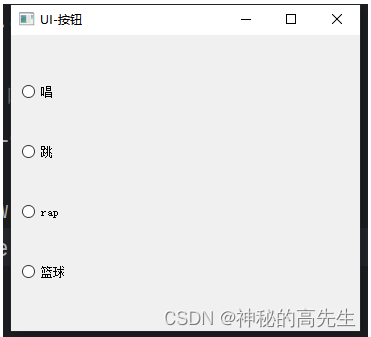
1.3 QCheckBox(复选框)
QCheckBox用于在多个选项中进行多选,用户可以选择多个选项import sys from PyQt5.QtWidgets import QApplication, QWidget, QButtonGroup, QVBoxLayout, QCheckBox if __name__ == '__main__': app = QApplication(sys.argv) w1 = QWidget() w1.setWindowTitle("UI-按钮") btnNames = ["唱","跳","RAP","篮球"] btnObjs = [] # 1. 创建一个布局容器 layout = QVBoxLayout() for bt_name in btnNames: # 2. 创建4个多选按钮 temp_btn = QCheckBox(bt_name) # 3. 将每个按钮添加到布局容器中 layout.addWidget(temp_btn) btnObjs.append(temp_btn) # 4. 窗口组件设置画布 w1.setLayout(layout) w1.show() app.exec_()- 1
- 2
- 3
- 4
- 5
- 6
- 7
- 8
- 9
- 10
- 11
- 12
- 13
- 14
- 15
- 16
- 17
- 18
- 19
- 20
- 21
- 22
- 23
- 24
- 25
- 26
- 27
- 28
- 29
- 30
- 31
注意:多选框不要使用按钮组对象,否则就变为多选框的单选效果
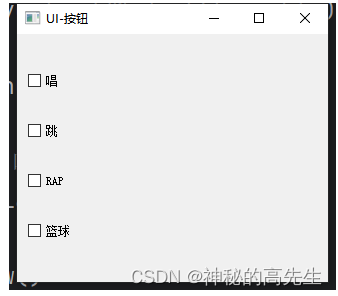
1.4 按钮的事件机制
在pyqt中,事件的调用过程是:
1.定义按钮或元素
2.通过事件名称.connect绑定事件
所以,我们需要定义事件的回调方法,注意,事件回调方法机制就保证事件内容是要返回回调可调用对象,建议在类中定义
1.4.1 用类的方式定义函数
import sys from PyQt5.QtWidgets import QApplication, QWidget, QButtonGroup, QVBoxLayout, QCheckBox, QPushButton class MyQtWindow(): def __init__(self): self.__initUI() def __initUI(self): app = QApplication(sys.argv) w1 = QWidget() w1.setWindowTitle("UI-按钮") # 创建一个普通按钮 btn1 = QPushButton("登录") # 绑定事件,单点击的时候调用say方法 btn1.clicked.connect(self.say) # 将按钮添加到父级中 btn1.setParent(w1) w1.show() app.exec_() def say(self): print(f"你好") if __name__ == '__main__': window = MyQtWindow()- 1
- 2
- 3
- 4
- 5
- 6
- 7
- 8
- 9
- 10
- 11
- 12
- 13
- 14
- 15
- 16
- 17
- 18
- 19
- 20
- 21
- 22
- 23
- 24
- 25
- 26
- 27
- 28
- 29
- 30
- 31
- 32
1.4.2 回调函数中传递参数
1.使用lambda表达式实现
btn1.clicked.connect(lambda x: self.say("123")) ... def say(self,arg): print(f"你好:{arg}")- 1
- 2
- 3
- 4
- 5
- 6
在这个例子中,
lambda函数将创建一个新的函数,该函数接受一个参数x,然后将这个参数和你的参数一起传递给say函数。2.定义辅助函数实现
btn1.clicked.connect(self.fuzhu_say) ... # 辅助函数 def fuzhu_say(self): self.say("参数") def say(self,arg): print(f"你好:{arg}")- 1
- 2
- 3
- 4
- 5
- 6
- 7
- 8
- 9
- 10
辅助函数传参需要在辅助函数中实现,如果你需要传递关键字参数,那么使用辅助函数可能是更好的选择
1.5 控制元素的位置和大小
对应元素使用:setGeometry(p_x,p_y,w,h) 函数
# 创建一个普通按钮 btn1 = QPushButton("登录") btn1.setGeometry(300,300,300,50)- 1
- 2
- 3
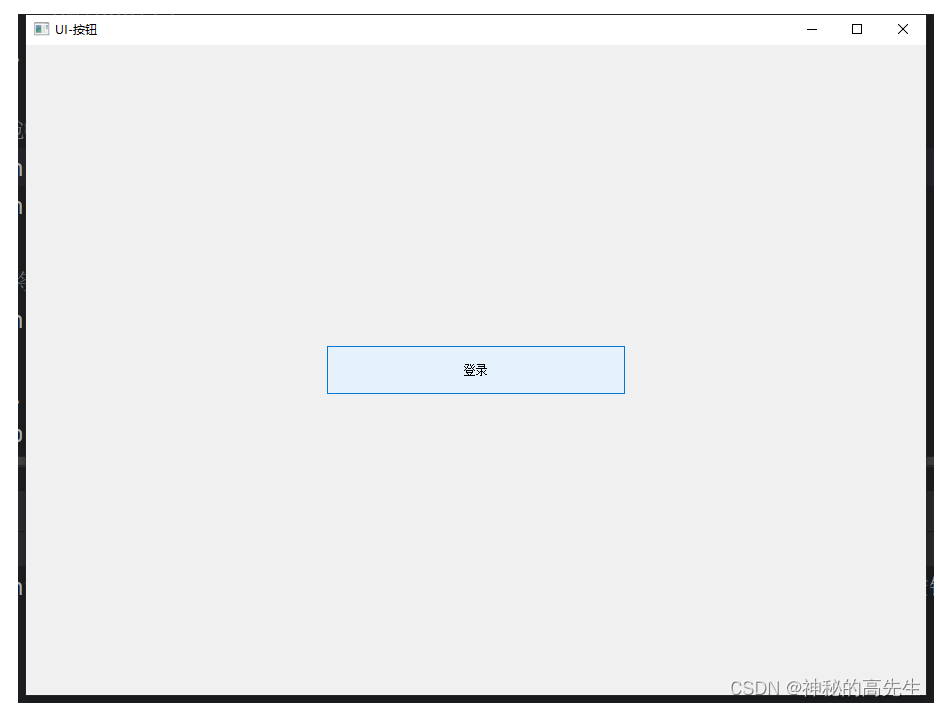
btn1.setGeometry(300,300,300,50)是一个在编程中设置图形界面元素(例如按钮)的位置和大小的语句。具体来说,这个语句的含义如下:btn1是一个按钮对象的引用。setGeometry是一个方法,用于设置按钮的大小和位置。(300,300,300,50)是一个四个数值的元组,分别表示按钮的左边界的x坐标、上边界的y坐标、宽度和高度。
所以,
btn1.setGeometry(300,300,300,50)的意思就是设置btn1这个按钮在界面上的位置为 (300,300),也就是将其左上角移动到屏幕的 (300,300) 位置,并且将其宽度设为300像素,高度设为50像素。1.6 设置单选或多选选中或取消选中
self.male_radio.setChecked(True) # 设置选中 self.female_radio.setChecked(False) # 设置取消选中- 1
- 2
2.文字
2.1 基础文字-QLabel
用于显示文本标签,不支持用户输入。
# 创建一个标题文字 q_label = QLabel("姓名", w)- 1
- 2

2.2 单行文本输入-QLineEdit
用于收集用户输入的单行文本,不支持多行文本。
q_label = QLineEdit("姓名", w)- 1
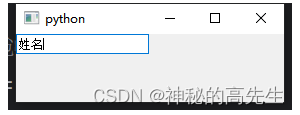
2.3 多行文本显示-QTextBrowser
用于显示多行文本,支持富文本、HTML等格式,但不支持用户编辑。
q_label = QTextBrowser(w) q_label.append("Hello World")- 1
- 2

2.4 多行文本编辑器-QTextEdit
用于收集用户输入的多行文本,支持富文本、HTML等格式,同时也支持用户编辑。
q_label = QTextEdit(w) q_label.append("Hello World")- 1
- 2

2.5 获取输入框值
(1) 单行文本输入框获取值
name = self.name_input.text()- 1
(2) 多行文本输入框获取值
intro = self.intro_input.toPlainText()- 1
2.6 清空输入框值
(1)单行文本输入框清空值
self.name_input.clear()- 1
(2)多行文本输入框清空值
self.intro_input.clear()- 1
3. 表单综合案例
import sys from PyQt5.QtWidgets import QApplication, QWidget, QLabel, QLineEdit, QTextEdit, QVBoxLayout, QHBoxLayout, QRadioButton, QCheckBox, QPushButton class FormApp(QWidget): def __init__(self): super().__init__() self.init_ui() def init_ui(self): self.setWindowTitle('表单界面') self.setGeometry(100, 100, 400, 300) self.name_label = QLabel('姓名:') self.name_input = QLineEdit() self.intro_label = QLabel('自我介绍:') self.intro_input = QTextEdit() self.gender_label = QLabel('性别:') self.male_radio = QRadioButton('男') self.female_radio = QRadioButton('女') self.hobby_label = QLabel('爱好:') self.sports_checkbox = QCheckBox('体育') self.music_checkbox = QCheckBox('音乐') self.travel_checkbox = QCheckBox('旅游') self.reset_button = QPushButton('重置') self.submit_button = QPushButton('提交') self.reset_button.clicked.connect(self.reset_form) self.submit_button.clicked.connect(self.submit_form) layout = QVBoxLayout() layout.addWidget(self.name_label) layout.addWidget(self.name_input) layout.addWidget(self.intro_label) layout.addWidget(self.intro_input) layout.addWidget(self.gender_label) layout.addWidget(self.male_radio) layout.addWidget(self.female_radio) layout.addWidget(self.hobby_label) layout.addWidget(self.sports_checkbox) layout.addWidget(self.music_checkbox) layout.addWidget(self.travel_checkbox) layout.addWidget(self.reset_button) layout.addWidget(self.submit_button) self.setLayout(layout) def reset_form(self): self.name_input.clear() self.intro_input.clear() self.male_radio.setChecked(True) self.female_radio.setChecked(False) self.sports_checkbox.setChecked(False) self.music_checkbox.setChecked(False) self.travel_checkbox.setChecked(False) def submit_form(self): name = self.name_input.text() intro = self.intro_input.toPlainText() gender = '男' if self.male_radio.isChecked() else '女' hobbies = [] if self.sports_checkbox.isChecked(): hobbies.append('体育') if self.music_checkbox.isChecked(): hobbies.append('音乐') if self.travel_checkbox.isChecked(): hobbies.append('旅游') print('姓名:', name) print('自我介绍:', intro) print('性别:', gender) print('爱好:', ', '.join(hobbies)) if __name__ == '__main__': app = QApplication(sys.argv) form = FormApp() form.show() sys.exit(app.exec_())- 1
- 2
- 3
- 4
- 5
- 6
- 7
- 8
- 9
- 10
- 11
- 12
- 13
- 14
- 15
- 16
- 17
- 18
- 19
- 20
- 21
- 22
- 23
- 24
- 25
- 26
- 27
- 28
- 29
- 30
- 31
- 32
- 33
- 34
- 35
- 36
- 37
- 38
- 39
- 40
- 41
- 42
- 43
- 44
- 45
- 46
- 47
- 48
- 49
- 50
- 51
- 52
- 53
- 54
- 55
- 56
- 57
- 58
- 59
- 60
- 61
- 62
- 63
- 64
- 65
- 66
- 67
- 68
- 69
- 70
- 71
- 72
- 73
- 74
- 75
- 76
- 77
- 78
- 79
- 80
- 81
- 82
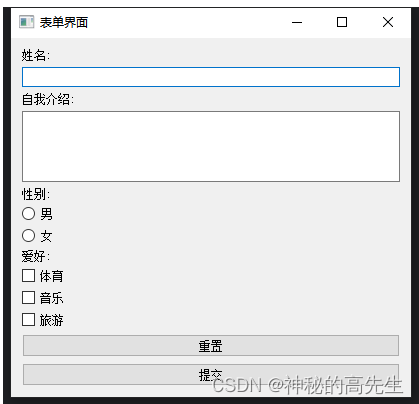
4.下拉列表
下拉列表(ComboBox)是一种常见的用户界面元素,它允许用户从预定义的选项列表中选择一个值。下拉列表通常用于提供选择,而不是自由文本输入。
self.label = QLabel('选择您的喜好:') self.combo_box = QComboBox() self.combo_box.addItem('体育') self.combo_box.addItem('音乐') self.combo_box.addItem('旅游')- 1
- 2
- 3
- 4
- 5

4.1 下拉获取值
selected_value = self.comboBox.currentText() # 获取当前选中的文本值 print("Selected Value:", selected_value)- 1
- 2
4.2 下拉清空值
self.comboBox.clear() # 清空下拉框中的所有选项- 1
4.3 下拉框选中值
通过下拉索引值选中(从0开始计数)
default_index = 2 # 设置默认选中的索引(从0开始计数) self.comboBox.setCurrentIndex(default_index)- 1
- 2
通过下拉框值选中
default_text = 'Item 2' # 设置默认选中的文本 self.comboBox.setCurrentText(default_text)- 1
- 2
4.4 下拉框添加元素
items = ['Item 1', 'Item 2', 'Item 3', 'Item 4'] self.comboBox.addItems(items)- 1
- 2
5.滑块
在 PyQt5 中,滑块(QSlider)是用于在一定范围内选择数值的界面元素。它允许用户通过滑动滑块来选择一个值。
self.slider = QSlider() # 默认是水平滑块 self.slider.setMinimum(0) # 设置最小值 self.slider.setMaximum(100) # 设置最大值 self.slider.setValue(50) # 设置默认值 self.slider.setTickPosition(QSlider.TicksBelow) # 设置刻度显示在滑块下方 self.slider.setTickInterval(10) # 设置刻度间隔- 1
- 2
- 3
- 4
- 5
- 6

完整demo
import sys from PyQt5.QtWidgets import QApplication, QMainWindow, QSlider, QLabel, QVBoxLayout, QWidget class SliderExample(QMainWindow): def __init__(self): super().__init__() self.initUI() def initUI(self): self.setWindowTitle('Slider Example') self.setGeometry(100, 100, 300, 200) layout = QVBoxLayout() self.slider = QSlider() # 默认是水平滑块 self.slider.setMinimum(0) # 设置最小值 self.slider.setMaximum(100) # 设置最大值 self.slider.setValue(50) # 设置默认值 self.slider.setTickPosition(QSlider.TicksBelow) # 设置刻度显示在滑块下方 self.slider.setTickInterval(10) # 设置刻度间隔 self.valueLabel = QLabel(f"Value: {self.slider.value()}") # 显示当前值的标签 layout.addWidget(self.slider) layout.addWidget(self.valueLabel) self.resetButton = QPushButton('Reset') self.resetButton.clicked.connect(self.resetSlider) layout.addWidget(self.resetButton) self.central_widget = QWidget() self.central_widget.setLayout(layout) self.setCentralWidget(self.central_widget) self.slider.valueChanged.connect(self.updateValueLabel) # 连接滑块值变化的信号与槽函数 def updateValueLabel(self, value): self.valueLabel.setText(f"Value: {value}") def resetSlider(self): self.slider.setValue(50) # 将滑块值重置为默认值 if __name__ == '__main__': app = QApplication(sys.argv) window = SliderExample() window.show() sys.exit(app.exec_())- 1
- 2
- 3
- 4
- 5
- 6
- 7
- 8
- 9
- 10
- 11
- 12
- 13
- 14
- 15
- 16
- 17
- 18
- 19
- 20
- 21
- 22
- 23
- 24
- 25
- 26
- 27
- 28
- 29
- 30
- 31
- 32
- 33
- 34
- 35
- 36
- 37
- 38
- 39
- 40
- 41
- 42
- 43
- 44
- 45
- 46
- 47
- 48
5.1 获取值
self.slider.value()- 1
5.2 重置与设置
self.slider.setValue(50) # 将滑块值重置为默认值- 1
5.3 值变化回调更新
self.slider.valueChanged.connect(self.updateValueLabel) # 连接滑块值变化的信号与槽函数 def updateValueLabel(self, value): self.valueLabel.setText(f"Value: {value}")- 1
- 2
- 3
- 4
6.进度条
进度条(QProgressBar)是一种用于表示进度或完成度的界面元素。在 PyQt5 中,你可以使用进度条来显示操作的进度,例如文件下载、任务执行等
self.progressBar = QProgressBar() # 创建一个进度条 self.progressBar.setMinimum(0) # 设置最小值:0 self.progressBar.setMaximum(100) # 设置最大值 100 self.progressBar.setValue(0) # 设置初始值 0- 1
- 2
- 3
- 4
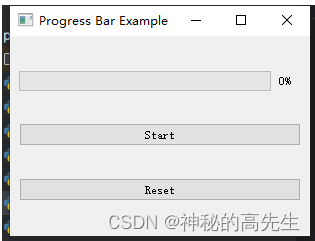
完整demo
import sys from PyQt5.QtWidgets import QApplication, QMainWindow, QProgressBar, QPushButton, QVBoxLayout, QWidget class ProgressBarExample(QMainWindow): def __init__(self): super().__init__() self.initUI() def initUI(self): self.setWindowTitle('Progress Bar Example') self.setGeometry(100, 100, 300, 200) layout = QVBoxLayout() self.progressBar = QProgressBar() # 创建一个进度条 self.progressBar.setMinimum(0) # 设置最小值:0 self.progressBar.setMaximum(100) # 设置最大值 100 self.progressBar.setValue(0) # 设置初始值 0 layout.addWidget(self.progressBar) self.startButton = QPushButton('Start') self.startButton.clicked.connect(self.startProgress) layout.addWidget(self.startButton) self.resetButton = QPushButton('Reset') self.resetButton.clicked.connect(self.resetProgress) layout.addWidget(self.resetButton) self.central_widget = QWidget() self.central_widget.setLayout(layout) self.setCentralWidget(self.central_widget) def startProgress(self): self.progressBar.setValue(0) # 开始时将进度条值重置为0 for i in range(101): self.progressBar.setValue(i) QApplication.processEvents() # 实时更新界面 if i == 100: self.progressBar.setValue(100) # 完成后将进度条值重置为0 def resetProgress(self): self.progressBar.setValue(0) # 将进度条值重置为0 if __name__ == '__main__': app = QApplication(sys.argv) window = ProgressBarExample() window.show() sys.exit(app.exec_())- 1
- 2
- 3
- 4
- 5
- 6
- 7
- 8
- 9
- 10
- 11
- 12
- 13
- 14
- 15
- 16
- 17
- 18
- 19
- 20
- 21
- 22
- 23
- 24
- 25
- 26
- 27
- 28
- 29
- 30
- 31
- 32
- 33
- 34
- 35
- 36
- 37
- 38
- 39
- 40
- 41
- 42
- 43
- 44
- 45
- 46
- 47
- 48
- 49
- 50
- 51
6.1 设置值且更新
self.progressBar.setValue(60) QApplication.processEvents() # 实时更新界面- 1
- 2
6.2 获取值
current_value = self.progressBar.value() print("Current Value:", current_value)- 1
- 2
7. 列表框
在 PyQt5 中,列表框(QListWidget)是用于显示一系列项目(项)的界面元素。每个项目可以包含文本、图像等内容。
self.listWidget = QListWidget() # 创建列表项 items = ['Item 1', 'Item 2', 'Item 3', 'Item 4'] for item_text in items: list_item = QListWidgetItem(item_text) # 创建一个列表项目 self.listWidget.addItem(list_item) # 添加到列表中- 1
- 2
- 3
- 4
- 5
- 6

完整案例:
import sys from PyQt5.QtWidgets import QApplication, QMainWindow, QListWidget, QListWidgetItem, QPushButton, QVBoxLayout, QWidget class ListWidgetExample(QMainWindow): def __init__(self): super().__init__() self.initUI() def initUI(self): self.setWindowTitle('List Widget Example') self.setGeometry(100, 100, 300, 200) layout = QVBoxLayout() self.listWidget = QListWidget() # 创建列表项 items = ['Item 1', 'Item 2', 'Item 3', 'Item 4'] for item_text in items: list_item = QListWidgetItem(item_text) # 创建一个列表项目 self.listWidget.addItem(list_item) # 添加到列表中 layout.addWidget(self.listWidget) self.addButton = QPushButton('Add Item') self.addButton.clicked.connect(self.addItem) layout.addWidget(self.addButton) self.removeButton = QPushButton('Remove Item') self.removeButton.clicked.connect(self.removeItem) layout.addWidget(self.removeButton) self.central_widget = QWidget() self.central_widget.setLayout(layout) self.setCentralWidget(self.central_widget) def addItem(self): new_item_text = 'New Item' new_item = QListWidgetItem(new_item_text) self.listWidget.addItem(new_item) def removeItem(self): selected_items = self.listWidget.selectedItems() for item in selected_items: self.listWidget.takeItem(self.listWidget.row(item)) if __name__ == '__main__': app = QApplication(sys.argv) window = ListWidgetExample() window.show() sys.exit(app.exec_())- 1
- 2
- 3
- 4
- 5
- 6
- 7
- 8
- 9
- 10
- 11
- 12
- 13
- 14
- 15
- 16
- 17
- 18
- 19
- 20
- 21
- 22
- 23
- 24
- 25
- 26
- 27
- 28
- 29
- 30
- 31
- 32
- 33
- 34
- 35
- 36
- 37
- 38
- 39
- 40
- 41
- 42
- 43
- 44
- 45
- 46
- 47
- 48
- 49
- 50
- 51
- 52
7.1 将列表项目添加到指定列表中
new_item_text = 'New Item' new_item = QListWidgetItem(new_item_text) self.listWidget.addItem(new_item)- 1
- 2
- 3
7.2 移除指定项目
item_to_remove = self.listWidget.item(2) # 获取第3个项目(索引为2) self.listWidget.takeItem(self.listWidget.row(item_to_remove))- 1
- 2
7.3 设置默认选中
default_row = 1 # 设置默认选中第2个项目(索引为1) self.listWidget.setCurrentRow(default_row)- 1
- 2
7.4 清空选中
self.listWidget.clearSelection()- 1
8. 表格
在 PyQt5 中,表格(QTableWidget)是一个用于显示二维表格数据的界面元素。它类似于电子表格,可以在单元格中显示文本、图像等内容。
self.tableWidget = QTableWidget(4, 3) # 创建一个4行3列的表格 # 设置3个表头 self.tableWidget.setHorizontalHeaderLabels(['Column 1', 'Column 2', 'Column 3'])- 1
- 2
- 3
for row in range(4): for col in range(3): item = QTableWidgetItem(data[row][col]) # 创建一个表格元素 data[行][列] self.tableWidget.setItem(row, col, item) # 添加元素- 1
- 2
- 3
- 4

完整案例:
import sys from PyQt5.QtWidgets import QApplication, QMainWindow, QTableWidget, QTableWidgetItem, QVBoxLayout, QWidget class TableWidgetExample(QMainWindow): def __init__(self): super().__init__() self.initUI() def initUI(self): self.setWindowTitle('Table Widget Example') self.setGeometry(100, 100, 400, 300) layout = QVBoxLayout() self.tableWidget = QTableWidget(4, 3) # 创建一个4行3列的表格 # 设置3个表头 self.tableWidget.setHorizontalHeaderLabels(['Column 1', 'Column 2', 'Column 3']) self.populateTable() layout.addWidget(self.tableWidget) self.central_widget = QWidget() self.central_widget.setLayout(layout) self.setCentralWidget(self.central_widget) def populateTable(self): data = [ ['Row 1, Col 1', 'Row 1, Col 2', 'Row 1, Col 3'], ['Row 2, Col 1', 'Row 2, Col 2', 'Row 2, Col 3'], ['Row 3, Col 1', 'Row 3, Col 2', 'Row 3, Col 3'], ['Row 4, Col 1', 'Row 4, Col 2', 'Row 4, Col 3'] ] for row in range(4): for col in range(3): item = QTableWidgetItem(data[row][col]) # 创建一个表格元素 data[行][列] self.tableWidget.setItem(row, col, item) # 添加元素 if __name__ == '__main__': app = QApplication(sys.argv) window = TableWidgetExample() window.show() sys.exit(app.exec_())- 1
- 2
- 3
- 4
- 5
- 6
- 7
- 8
- 9
- 10
- 11
- 12
- 13
- 14
- 15
- 16
- 17
- 18
- 19
- 20
- 21
- 22
- 23
- 24
- 25
- 26
- 27
- 28
- 29
- 30
- 31
- 32
- 33
- 34
- 35
- 36
- 37
- 38
- 39
- 40
- 41
- 42
- 43
- 44
- 45
- 46
- 47
- 48
8.1添加行
使用
insertRow(row)方法可以在指定位置插入一行。pythonCopy code tableWidget.insertRow(row_index)- 1
- 2
8.2添加列
使用
insertColumn(column)方法可以在指定位置插入一列。pythonCopy code tableWidget.insertColumn(column_index)- 1
- 2
8.3 设置单元格内容
使用
setItem(row, column, item)方法可以将一个 QTableWidgetItem 对象放置到指定行和列的单元格中。pythonCopy codeitem = QTableWidgetItem("Cell Value") tableWidget.setItem(row_index, column_index, item)- 1
- 2
8.4 获取单元格内容
使用
item(row, column)方法可以获取指定行和列的单元格中的 QTableWidgetItem 对象。pythonCopy codeitem = tableWidget.item(row_index, column_index) cell_value = item.text() if item is not None else ""- 1
- 2
8.6 合并单元格
使用
setSpan(row, column, row_span, column_span)方法可以合并指定范围内的单元格。pythonCopy code tableWidget.setSpan(row_index, column_index, row_span, column_span)- 1
- 2
8.7 清除内容
使用
clear()方法可以清除表格中的所有内容。pythonCopy code tableWidget.clear()- 1
- 2
8.8 移除行和列
使用
removeRow(row)和removeColumn(column)方法可以移除指定行和列。pythonCopy codetableWidget.removeRow(row_index) tableWidget.removeColumn(column_index)- 1
- 2
8.9 设置单元格对齐
使用
item(row, column).setTextAlignment(alignment)方法可以设置指定单元格的文本对齐方式。pythonCopy codeitem = QTableWidgetItem("Aligned Text") item.setTextAlignment(Qt.AlignCenter) # 或者 Qt.AlignLeft, Qt.AlignRight, Qt.AlignTop, Qt.AlignBottom 等 tableWidget.setItem(row_index, column_index, item)- 1
- 2
- 3
8.10 综合案例-带操作列的表格
import sys from PyQt5.QtWidgets import QApplication, QMainWindow, QTableWidget, QTableWidgetItem, QPushButton, QVBoxLayout, QWidget class TableWithButtonsExample(QMainWindow): def __init__(self): super().__init__() self.initUI() def initUI(self): self.setWindowTitle('Table with Buttons Example') self.setGeometry(100, 100, 600, 400) layout = QVBoxLayout() self.tableWidget = QTableWidget(4, 4) # 创建一个4行4列的表格 self.tableWidget.setHorizontalHeaderLabels(['Select', 'Name', 'Age', 'Actions']) self.populateTable() layout.addWidget(self.tableWidget) self.central_widget = QWidget() self.central_widget.setLayout(layout) self.setCentralWidget(self.central_widget) def populateTable(self): data = [ {'name': 'Alice', 'age': 25}, {'name': 'Bob', 'age': 30}, {'name': 'Carol', 'age': 28}, {'name': 'David', 'age': 22} ] for row, item_data in enumerate(data): select_item = QTableWidgetItem() select_item.setFlags(select_item.flags() | Qt.ItemIsUserCheckable) select_item.setCheckState(Qt.Unchecked) self.tableWidget.setItem(row, 0, select_item) name_item = QTableWidgetItem(item_data['name']) self.tableWidget.setItem(row, 1, name_item) age_item = QTableWidgetItem(str(item_data['age'])) self.tableWidget.setItem(row, 2, age_item) view_button = QPushButton('View') edit_button = QPushButton('Edit') delete_button = QPushButton('Delete') button_container = QWidget() button_layout = QHBoxLayout() button_layout.addWidget(view_button) button_layout.addWidget(edit_button) button_layout.addWidget(delete_button) button_container.setLayout(button_layout) self.tableWidget.setCellWidget(row, 3, button_container) if __name__ == '__main__': app = QApplication(sys.argv) window = TableWithButtonsExample() window.show() sys.exit(app.exec_())- 1
- 2
- 3
- 4
- 5
- 6
- 7
- 8
- 9
- 10
- 11
- 12
- 13
- 14
- 15
- 16
- 17
- 18
- 19
- 20
- 21
- 22
- 23
- 24
- 25
- 26
- 27
- 28
- 29
- 30
- 31
- 32
- 33
- 34
- 35
- 36
- 37
- 38
- 39
- 40
- 41
- 42
- 43
- 44
- 45
- 46
- 47
- 48
- 49
- 50
- 51
- 52
- 53
- 54
- 55
- 56
- 57
- 58
- 59
- 60
- 61
- 62
- 63
- 64
- 65

9. 时间选择器
在 PyQt5 中,可以使用 QDateTimeEdit 组件来实现日期时间选择器。
self.dateTimeEdit = QDateTimeEdit() # 创建一个时间选择器 self.dateTimeEdit.setDateTime(QDateTime.currentDateTime()) # 设置默认值为当前日期时间- 1
- 2
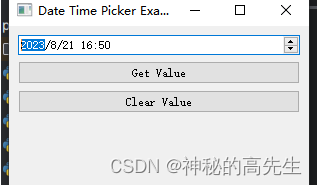
import sys from PyQt5.QtWidgets import QApplication, QMainWindow, QDateTimeEdit, QVBoxLayout, QPushButton, QLabel, QWidget from PyQt5.QtCore import QDateTime class DateTimePickerExample(QMainWindow): def __init__(self): super().__init__() self.initUI() def initUI(self): self.setWindowTitle('Date Time Picker Example') self.setGeometry(100, 100, 300, 200) layout = QVBoxLayout() self.dateTimeEdit = QDateTimeEdit() # 创建一个时间选择器 self.dateTimeEdit.setDateTime(QDateTime.currentDateTime()) # 设置默认值为当前日期时间 layout.addWidget(self.dateTimeEdit) self.getValueButton = QPushButton('Get Value') self.getValueButton.clicked.connect(self.getValue) layout.addWidget(self.getValueButton) self.clearValueButton = QPushButton('Clear Value') self.clearValueButton.clicked.connect(self.clearValue) layout.addWidget(self.clearValueButton) self.valueLabel = QLabel() layout.addWidget(self.valueLabel) self.central_widget = QWidget() self.central_widget.setLayout(layout) self.setCentralWidget(self.central_widget) def getValue(self): selected_datetime = self.dateTimeEdit.dateTime() formatted_datetime = selected_datetime.toString("yyyy-MM-dd HH:mm:ss") self.valueLabel.setText(f"Selected Value: {formatted_datetime}") def clearValue(self): self.dateTimeEdit.clear() # 清空日期时间选择器的值 self.valueLabel.setText("Selected Value: Cleared") if __name__ == '__main__': app = QApplication(sys.argv) window = DateTimePickerExample() window.show() sys.exit(app.exec_())- 1
- 2
- 3
- 4
- 5
- 6
- 7
- 8
- 9
- 10
- 11
- 12
- 13
- 14
- 15
- 16
- 17
- 18
- 19
- 20
- 21
- 22
- 23
- 24
- 25
- 26
- 27
- 28
- 29
- 30
- 31
- 32
- 33
- 34
- 35
- 36
- 37
- 38
- 39
- 40
- 41
- 42
- 43
- 44
- 45
- 46
- 47
- 48
- 49
- 50
9.1 设置时间
self.dateTimeEdit.setDateTime(QDateTime.currentDateTime()) # 设置默认值为当前日期时间- 1
使用字符串日期设置:
time_str = "2023-08-21 15:30:00" datetime_value = QDateTime.fromString(time_str, "yyyy-MM-dd HH:mm:ss") self.dateTimeEdit.setDateTime(datetime_value)- 1
- 2
- 3
9.2 获取时间
selected_datetime = self.dateTimeEdit.dateTime() formatted_datetime = selected_datetime.toString("yyyy-MM-dd HH:mm:ss")- 1
- 2
10. 文件选择器
import sys from PyQt5.QtWidgets import QApplication, QMainWindow, QPushButton, QFileDialog class FileDialogExample(QMainWindow): def __init__(self): super().__init__() self.initUI() def initUI(self): self.setGeometry(100, 100, 300, 200) self.setWindowTitle('File Dialog Example') self.button = QPushButton('Open File Dialog', self) self.button.setGeometry(100, 100, 150, 30) self.button.clicked.connect(self.showFileDialog) def showFileDialog(self): options = QFileDialog.Options() options |= QFileDialog.ReadOnly # 可选:设置文件选择框为只读模式 file_path, _ = QFileDialog.getOpenFileName(self, "Open File", "", "All Files (*);;Text Files (*.txt)", options=options) if file_path: print("Selected file:", file_path) if __name__ == '__main__': app = QApplication(sys.argv) ex = FileDialogExample() ex.show() sys.exit(app.exec_())- 1
- 2
- 3
- 4
- 5
- 6
- 7
- 8
- 9
- 10
- 11
- 12
- 13
- 14
- 15
- 16
- 17
- 18
- 19
- 20
- 21
- 22
- 23
- 24
- 25
- 26
- 27
- 28
- 29
- 30
- 31
- 32
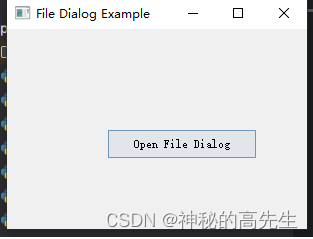
点击按钮会弹出一个文件选择框,允许你选择文件。你可以根据自己的需求进行修改和扩展。在
getOpenFileName方法中,你可以通过调整第四个参数的字符串来指定不同的文件过滤器。这个参数使用了一种类似于 “文件类型描述 (*扩展名);;文件类型描述 (*扩展名)” 的格式。11. 显示图片
在 PyQt5 中,你可以使用
QLabel来显示图片。要显示图片,你需要使用QPixmap创建一个图像对象,然后将它设置给QLabel的setPixmap方法。import sys from PyQt5.QtWidgets import QApplication, QMainWindow, QLabel, QVBoxLayout, QWidget from PyQt5.QtGui import QPixmap class ImageDisplayExample(QMainWindow): def __init__(self): super().__init__() self.initUI() def initUI(self): self.setGeometry(100, 100, 400, 300) self.setWindowTitle('Image Display Example') central_widget = QWidget(self) self.setCentralWidget(central_widget) layout = QVBoxLayout() central_widget.setLayout(layout) self.image_label = QLabel(self) layout.addWidget(self.image_label) self.loadImage() def loadImage(self): pixmap = QPixmap('path_to_your_image.jpg') # 替换为你的图片路径 self.image_label.setPixmap(pixmap) self.image_label.setAlignment(Qt.AlignCenter) if __name__ == '__main__': app = QApplication(sys.argv) ex = ImageDisplayExample() ex.show() sys.exit(app.exec_())- 1
- 2
- 3
- 4
- 5
- 6
- 7
- 8
- 9
- 10
- 11
- 12
- 13
- 14
- 15
- 16
- 17
- 18
- 19
- 20
- 21
- 22
- 23
- 24
- 25
- 26
- 27
- 28
- 29
- 30
- 31
- 32
- 33
- 34
- 35
- 36
在这个案例中,你需要将
'path_to_your_image.jpg'替换为你自己的图片文件的路径。QPixmap类用于加载图片,而QLabel则用于显示图像。通过调用setPixmap方法,你可以将加载的图像设置给QLabel,然后使用setAlignment方法来设置图像在QLabel中的对齐方式。
12. 工具栏
使用
QMenu和QToolBar来创建菜单和工具栏。菜单用于创建应用程序的导航菜单,而工具栏则提供了快速访问常用功能的方式import sys from PyQt5.QtWidgets import QApplication, QMainWindow, QAction, QMenu, QToolBar class MenuAndToolbarExample(QMainWindow): def __init__(self): super().__init__() self.initUI() def initUI(self): self.setGeometry(100, 100, 800, 600) self.setWindowTitle('Menu and Toolbar Example') self.createMenu() self.createToolbar() def createMenu(self): menubar = self.menuBar() file_menu = menubar.addMenu('File') edit_menu = menubar.addMenu('Edit') new_action = QAction('New', self) new_action.triggered.connect(self.newFile) file_menu.addAction(new_action) open_action = QAction('Open', self) open_action.triggered.connect(self.openFile) file_menu.addAction(open_action) exit_action = QAction('Exit', self) exit_action.triggered.connect(self.close) file_menu.addAction(exit_action) undo_action = QAction('Undo', self) edit_menu.addAction(undo_action) redo_action = QAction('Redo', self) edit_menu.addAction(redo_action) def createToolbar(self): toolbar = QToolBar(self) self.addToolBar(toolbar) new_action = QAction('New', self) new_action.triggered.connect(self.newFile) toolbar.addAction(new_action) open_action = QAction('Open', self) open_action.triggered.connect(self.openFile) toolbar.addAction(open_action) save_action = QAction('Save', self) toolbar.addAction(save_action) def newFile(self): print("New File") def openFile(self): print("Open File") if __name__ == '__main__': app = QApplication(sys.argv) ex = MenuAndToolbarExample() ex.show() sys.exit(app.exec_())- 1
- 2
- 3
- 4
- 5
- 6
- 7
- 8
- 9
- 10
- 11
- 12
- 13
- 14
- 15
- 16
- 17
- 18
- 19
- 20
- 21
- 22
- 23
- 24
- 25
- 26
- 27
- 28
- 29
- 30
- 31
- 32
- 33
- 34
- 35
- 36
- 37
- 38
- 39
- 40
- 41
- 42
- 43
- 44
- 45
- 46
- 47
- 48
- 49
- 50
- 51
- 52
- 53
- 54
- 55
- 56
- 57
- 58
- 59
- 60
- 61
- 62
- 63
- 64
- 65
- 66
- 67

我们创建了一个具有简单菜单和工具栏的窗口。
QMenu用于创建菜单,QToolBar用于创建工具栏。我们创建了一个 “File” 菜单和一个 “Edit” 菜单,每个菜单都有相应的操作。在工具栏中,我们放置了 “New” 和 “Open” 功能的按钮。当点击菜单项或工具栏按钮时,与之相关联的槽函数将被触发。在这个案例中,点击 “New” 或 “Open” 菜单项或工具栏按钮会分别调用
newFile和openFile方法,这里我们只是打印了一些文本,但你可以在这些方法中执行自己的操作。13. 隐藏窗口栏和设置窗口图标
13.1 隐藏窗口栏
self.setWindowFlags(Qt.FramelessWindowHint) # 设置窗口标志位为无边框- 1

13.2 设置窗口图标
要在 PyQt5 中设置窗口的小图标(窗口图标),你可以使用
QIcon类来加载图标文件,并将其设置给窗口对象的setWindowIcon方法from PyQt5.QtGui import QIcon icon = QIcon('path_to_your_icon.png') # 替换为你的图标文件路径 self.setWindowIcon(icon)- 1
- 2
- 3
- 4

14. 网页视图
首先第一步需要安装PyQtWebEngine模块
pip install PyQtWebEngine- 1
编写代码
import sys from PyQt5.QtCore import QUrl from PyQt5.QtWidgets import QApplication, QMainWindow, QVBoxLayout, QWidget from PyQt5.QtWebEngineWidgets import QWebEngineView class WebViewExample(QMainWindow): def __init__(self): super().__init__() self.init_ui() def init_ui(self): self.setWindowTitle('网页视图示例') self.setGeometry(100, 100, 800, 600) self.webview = QWebEngineView() self.webview.setUrl(QUrl('https://www.baidu.com')) # Load the OpenAI website layout = QVBoxLayout() layout.addWidget(self.webview) central_widget = QWidget() central_widget.setLayout(layout) self.setCentralWidget(central_widget) if __name__ == '__main__': app = QApplication(sys.argv) example = WebViewExample() example.show() sys.exit(app.exec_())- 1
- 2
- 3
- 4
- 5
- 6
- 7
- 8
- 9
- 10
- 11
- 12
- 13
- 14
- 15
- 16
- 17
- 18
- 19
- 20
- 21
- 22
- 23
- 24
- 25
- 26
- 27
- 28
- 29
- 30
- 31

15.音频和视频播放器
QMediaPlayer来实现音频和视频播放功能。QMediaPlayer是一个多媒体播放器,它可以用来播放音频和视频文件。15.1 音乐播放器
import sys from PyQt5.QtCore import QUrl from PyQt5.QtWidgets import QApplication, QMainWindow, QPushButton, QVBoxLayout, QWidget from PyQt5.QtMultimedia import QMediaPlayer, QMediaContent class AudioPlayerExample(QMainWindow): def __init__(self): super().__init__() self.init_ui() def init_ui(self): self.setWindowTitle('音频播放器示例') self.setGeometry(100, 100, 300, 100) self.media_player = QMediaPlayer() self.media_player.setMedia(QMediaContent(QUrl.fromLocalFile('static/msc.mp3'))) # Replace with your audio file path self.play_button = QPushButton('播放') self.play_button.clicked.connect(self.play_audio) self.stop_button = QPushButton('暂停') self.stop_button.clicked.connect(self.stop_audio) layout = QVBoxLayout() layout.addWidget(self.play_button) layout.addWidget(self.stop_button) central_widget = QWidget() central_widget.setLayout(layout) self.setCentralWidget(central_widget) def play_audio(self): self.media_player.play() def stop_audio(self): self.media_player.pause() if __name__ == '__main__': app = QApplication(sys.argv) example = AudioPlayerExample() example.show() sys.exit(app.exec_())- 1
- 2
- 3
- 4
- 5
- 6
- 7
- 8
- 9
- 10
- 11
- 12
- 13
- 14
- 15
- 16
- 17
- 18
- 19
- 20
- 21
- 22
- 23
- 24
- 25
- 26
- 27
- 28
- 29
- 30
- 31
- 32
- 33
- 34
- 35
- 36
- 37
- 38
- 39
- 40
- 41
- 42
- 43
- 44
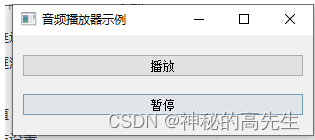
16. 弹窗
16.1 消息框
QMessageBox:用于显示各种类型的消息框,如信息、警告、错误等。
from PyQt5.QtWidgets import QApplication, QMainWindow, QPushButton, QMessageBox class MyWindow(QMainWindow): def __init__(self): super().__init__() button = QPushButton("Show Message Box", self) button.clicked.connect(self.show_message_box) def show_message_box(self): QMessageBox.information(self, "Information", "This is an information message.") app = QApplication([]) window = MyWindow() window.show() app.exec_()- 1
- 2
- 3
- 4
- 5
- 6
- 7
- 8
- 9
- 10
- 11
- 12
- 13
- 14
- 15
- 16
- 17
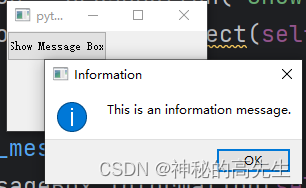
16.2 操作对话框
QInputDialog:用于获取用户输入的对话框。
from PyQt5.QtWidgets import QApplication, QMainWindow, QPushButton, QInputDialog class MyWindow(QMainWindow): def __init__(self): super().__init__() button = QPushButton("Get Input", self) button.clicked.connect(self.get_input) def get_input(self): text, ok = QInputDialog.getText(self, "Input Dialog", "Enter your name:") if ok: print(f"Entered name: {text}") app = QApplication([]) window = MyWindow() window.show() app.exec_()- 1
- 2
- 3
- 4
- 5
- 6
- 7
- 8
- 9
- 10
- 11
- 12
- 13
- 14
- 15
- 16
- 17
- 18
- 19
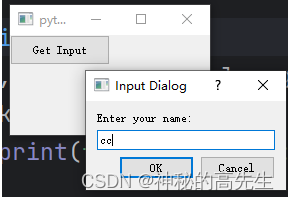
16.3 文件对话框
QFileDialog:用于打开文件对话框或保存文件对话框。
from PyQt5.QtWidgets import QApplication, QMainWindow, QPushButton, QFileDialog class MyWindow(QMainWindow): def __init__(self): super().__init__() button = QPushButton("Open File", self) button.clicked.connect(self.open_file) def open_file(self): options = QFileDialog.Options() options |= QFileDialog.ReadOnly file_name, _ = QFileDialog.getOpenFileName(self, "Open File", "", "All Files (*)", options=options) if file_name: print(f"Selected file: {file_name}") app = QApplication([]) window = MyWindow() window.show() app.exec_()- 1
- 2
- 3
- 4
- 5
- 6
- 7
- 8
- 9
- 10
- 11
- 12
- 13
- 14
- 15
- 16
- 17
- 18
- 19
- 20
- 21
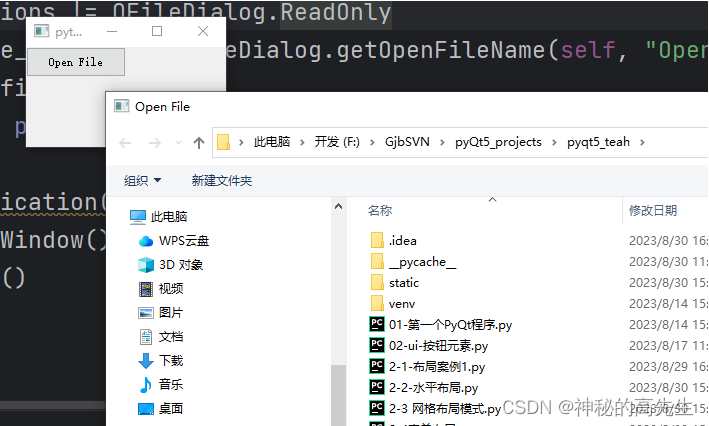
代码解释:
options |= QFileDialog.ReadOnly- 1
这个代码的意思是将
options变量与QFileDialog.ReadOnly进行按位或操作,并将结果赋值给options变量。QFileDialog.ReadOnly是一个常量,它表示一个标志,用于在QFileDialog中设置只读选项。当你按位或操作符|将这个标志与其他选项组合时,你可以在QFileDialog中设置多个选项。例如,假设你有以下代码:
options = QFileDialog.Options() options |= QFileDialog.ReadOnly options |= QFileDialog.DontUseNativeDialog- 1
- 2
- 3
这里,我们首先创建了一个空的
QFileDialog.Options对象。然后,通过options |= QFileDialog.ReadOnly,我们将只读选项添加到了options中。接着,通过options |= QFileDialog.DontUseNativeDialog,我们又将不使用原生对话框的选项添加到了options中。最终,
options变量会包含这两个选项的组合,你可以将其传递给QFileDialog的相关方法,以便按照所选的选项来打开文件对话框。17. 打包方法
17.1 环境准备
首先安装pyinstaller,使用安装命令:pip install pyinstaller;使用清华大学镜像源加快速度
pip install pyinstaller -i https://pypi.tuna.tsinghua.edu.cn/simple- 1
17.2 进行打包
我们写的python脚本是不能脱离python解释器单独运行的,所以在打包的时候,至少会将python解释器和脚本一起打包,同样,为了打包的exe能正常运行,会把我们所有安装的第三方包一并打包到exe。
即使我们的项目只使用的一个requests包,但是可能我们还安装了其他n个包,但是他不管,因为包和包只有依赖关系的。比如我们只装了一个requests包,但是requests包会顺带装了一些其他依赖的小包,所以为了安全,只能将所有第三方包+python解释器一起打包。
1. 单文件打包
去除控制台打包
pyinstaller -F -w 文件地址- 1
带控制台打包
pyinstaller -F 文件地址- 1
打包指定exe 图标打包
pyinstaller -F -i 图标 主文件- 1
2. 多文件打包
pyinstaller [主文件] -p [其他文件1] -p [其他文件2] --hidden-import [自建模块1] --hidden-import [自建模块2]- 1
-
相关阅读:
Java学习07——原码、反码和补码
高NA (数值孔径)物镜的分析
sharedPtr
LeetCode简单题之最好的扑克手牌
接口测试入门必会知识总结(学习笔记)
搭建高可用k8s
linux排查java进程占用CPU过高原因方法
小程序:实现翻页功能(解决数据过载)
作业-11.8
Matlab自学笔记三十一:结构数组的创建、索引和预分配内存
- 原文地址:https://blog.csdn.net/gjb760662328/article/details/132765000